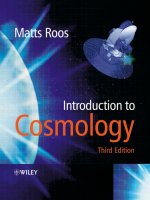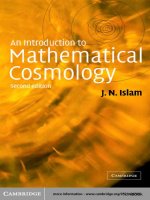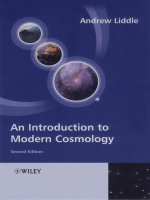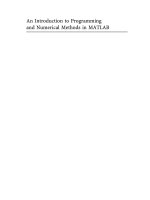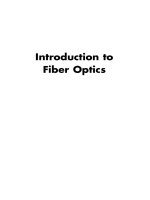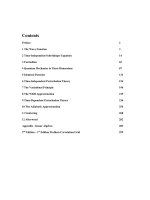- Trang chủ >>
- Khoa Học Tự Nhiên >>
- Vật lý
An introduction to mathematical cosmology 2nd ed j islam
Bạn đang xem bản rút gọn của tài liệu. Xem và tải ngay bản đầy đủ của tài liệu tại đây (3.33 MB, 264 trang )
TLFeBOOK
This page intentionally left blank
TLFeBOOK
AN INTRODUCTION TO MATHEMATICAL
COSMOLOGY
This book provides a concise introduction to the mathematical
aspects of the origin, structure and evolution of the universe. The
book begins with a brief overview of observational and
theoretical cosmology, along with a short introduction to general
relativity. It then goes on to discuss Friedmann models, the
Hubble constant and deceleration parameter, singularities, the
early universe, inflation, quantum cosmology and the distant
future of the universe. This new edition contains a rigorous
derivation of the Robertson–Walker metric. It also discusses the
limits to the parameter space through various theoretical and
observational constraints, and presents a new inflationary
solution for a sixth degree potential.
This book is suitable as a textbook for advanced undergradu-
ates and beginning graduate students. It will also be of interest to
cosmologists, astrophysicists, applied mathematicians and
mathematical physicists.
received his PhD and ScD from the
University of Cambridge. In 1984 he became Professor of
Mathematics at the University of Chittagong, Bangladesh, and is
currently Director of the Research Centre for Mathematical and
Physical Sciences, University of Chittagong. Professor Islam has
held research positions in university departments and institutes
throughout the world, and has published numerous papers on
quantum field theory, general relativity and cosmology. He has
also written and contributed to several books.
TLFeBOOK
TLFeBOOK
AN INTRODUCTION TO
MATHEMATICAL
COSMOLOGY
Second edition
J. N. ISLAM
Research Centre for Mathematical and Physical Sciences,
University of Chittagong, Bangladesh
TLFeBOOK
The Pitt Building, Trumpington Street, Cambridge, United Kingdom
The Edinburgh Building, Cambridge CB2 2RU, UK
40 West 20th Street, New York, NY 10011-4211, USA
477 Williamstown Road, Port Melbourne, VIC 3207, Australia
Ruiz de Alarcón 13, 28014 Madrid, Spain
Dock House, The Waterfront, Cape Town 8001, South Africa
First published in printed format
ISBN 0-521-49650-0 hardback
ISBN 0-521-49973-9
p
a
p
erback
ISBN 0-511-01849-5 eBook
Cambrid
g
e University Press 1992, 2004
2001
(netLibrary)
©
TLFeBOOK
Contents
Prefacetothefirsteditionpageix
Prefacetothesecondeditionxi
1Somebasicconceptsandanoverviewofcosmology1
2Introductiontogeneralrelativity12
2.1Summaryofgeneralrelativity12
2.2Somespecialtopicsingeneralrelativity18
2.2.1Killingvectors18
2.2.2Tensordensities21
2.2.3GaussandStokestheorems24
2.2.4Theactionprincipleforgravitation28
2.2.5Somefurthertopics32
3TheRobertson–Walkermetric37
3.1 A simple derivation of the Robertson–Walker
metric37
3.2 Some geometric properties of the Robertson–
Walkermetric42
3.3 Some kinematic properties of the Robertson–
Walkermetric45
3.4 The Einstein equations for the Robertson–Walker
metric51
3.5 Rigorous derivation of the Robertson–Walker
metric53
4TheFriedmannmodels60
4.1Introduction60
4.2Exactsolutionforzeropressure64
4.3Solutionforpureradiation67
4.4Behaviourneartϭ068
4.5 Exact solution connecting radiation and matter
eras68
v
TLFeBOOK
4.6Thered-shiftversusdistancerelation71
4.7Particleandeventhorizons73
5TheHubbleconstantandthedecelerationparameter76
5.1Introduction76
5.2 Measurement of H
0
77
5.3 Measurement of q
0
80
5.4Furtherremarksaboutobservationalcosmology85
AppendixtoChapter590
6Modelswithacosmologicalconstant94
6.1Introduction94
6.2 Further remarks about the cosmological
constant98
6.3Limitsonthecosmologicalconstant100
6.4 Some recent developments regarding the
cosmologicalconstantandrelatedmatters102
6.4.1Introduction102
6.4.2 An exact solution with cosmological
constant104
6.4.3Restrictionofparameterspace107
7Singularitiesincosmology112
7.1Introduction112
7.2Homogeneouscosmologies113
7.3 Some results of general relativistic
hydrodynamics115
7.4Definitionofsingularities118
7.5Anexampleofasingularitytheorem120
7.6Ananisotropicmodel121
7.7Theoscillatoryapproachtosingularities122
7.8Asingularity-freeuniverse?126
8Theearlyuniverse128
8.1Introduction128
8.2Theveryearlyuniverse135
8.3Equationsintheearlyuniverse142
8.4 Black-body radiation and the temperature of the
earlyuniverse143
8.5Evolutionofthemass-energydensity148
8.6Nucleosynthesisintheearlyuniverse153
8.7Furtherremarksaboutheliumanddeuterium159
8.8Neutrinotypesandmasses164
vi Contents
TLFeBOOK
9Theveryearlyuniverseandinflation166
9.1Introduction166
9.2Inflationarymodels–qualitativediscussion167
9.3Inflationarymodels–quantitativedescription174
9.4Anexactinflationarysolution178
9.5Furtherremarksoninflation180
9.6Moreinflationarysolutions183
AppendixtoChapter9186
10Quantumcosmology189
10.1Introduction189
10.2Hamiltonianformalism191
10.3 The Schrödinger functional equation for a
scalarfield195
10.4Afunctionaldifferentialequation197
10.5Solutionforascalarfield199
10.6Thefreeelectromagneticfield199
10.7TheWheeler–DeWittequation201
10.8Pathintegrals202
10.9Conformalfluctuations206
10.10Furtherremarksaboutquantumcosmology209
11Thedistantfutureoftheuniverse211
11.1Introduction211
11.2Threewaysforastartodie211
11.3Galacticandsupergalacticblackholes213
11.4Black-holeevaporation215
11.5Slowandsubtlechanges216
11.6Acollapsinguniverse218
Appendix220
Bibliography238
Index247
Contents vii
TLFeBOOK
TLFeBOOK
Preface to the first edition
Ever since I wrote my semi-popular book The Ultimate Fate of the
Universe I have been meaning to write a technical version of it. There are
of course many good books on cosmology and it seemed doubtful to me
whether the inclusion of a chapter on the distant future of the universe
would itself justify another book. However, in recent years there have been
two interesting developments in cosmology, namely inflationary models
and quantum cosmology, with their connection with particle physics and
quantum mechanics, and I believe the time is ripe for a book containing
these topics. Accordingly, this book has a chapter each on inflationary
models, quantum cosmology and the distant future of the universe (as well
as a chapter on singularities not usually contained in the standard texts).
This is essentially an introductory book. None of the topics dealt with
have been treated exhaustively. However, I have tried to include enough
introductory material and references so that the reader can pursue the
topic of his interest further.
A knowledge of general relativity is helpful; I have included a brief
exposition of it in Chapter 2 for those who are not familiar with it. This
material is very standard; the form given here is taken essentially from my
book Rotating Fields in General Relativity.
In the process of writing this book, I discovered two exact cosmological
solutions, one connecting radiation and matter dominated eras and the
other representing an inflationary model for a sixth degree potential.
These have been included in Sections 4.5 and 9.4 respectively as I believe
they are new and have some physical relevance.
I am grateful to J. V. Narlikar and M. J. Rees for providing some useful
references. I am indebted to a Cambridge University Press reader for
helpful comments; the portion on observational cosmology has I believe
improved considerably as a result of these comments. I am grateful to
ix
TLFeBOOK
F. J. Dyson for his ideas included in the last chapter. I thank Maureen
Storey of Cambridge University Press for her efficient and constructive
subediting.
I am grateful to my wife Suraiya and daughters Nargis and Sadaf and
my son-in-law Kamel for support and encouragement during the period
this book was written. I have discussed plans for my books with Mrs Mary
Wraith, who kindly typed the manuscript for my first book. For more than
three decades she has been friend, philosopher and mentor for me and my
wife and in recent years a very affectionate godmother (‘Goddy’) to my
daughters. This book is fondly dedicated to this remarkable person.
Jamal Nazrul Islam
Chittagong, 1991
x Preface to the first edition
TLFeBOOK
Preface to the second edition
The material in the earlier edition, to which there appears to have been a
favourable response, has been kept intact as far as possible in this new
edition except for minor changes. A number of new additions have been
made. Some standard topics have been added to the introduction to
general relativity, such as Killing vectors. Not all these topics are used later
in the book, but some may be of use to the beginning student for mathe-
matical aspects of cosmological studies. Observational aspects have been
brought up to date in an extended chapter on the cosmological constant.
As this is a book on mathematical cosmology, the treatment of observa-
tions is not definitive or exhaustive by any means, but hopefully it is ade-
quate. To clarify the role of the cosmological constant, much discussed in
recent years, an exact, somewhat unusual solution with cosmological con-
stant is included. Whether the solution is new is not clear: it is meant to
provide a ‘comprehension exercise’. One reviewer of the earlier edition
wondered why the Hubble constant and the deceleration parameter were
chosen for a separate chapter. I believe these two parameters are among
the most important in cosmology; adequate understanding of these helps
to assess observations generally. Within the last year or two, through anal-
yses of supernovae in distant galaxies, evidence seems to be emerging that
the universe may be accelerating, or at least the deceleration may be not as
much as was supposed earlier. If indeed the universe is accelerating, the
nomenclature ‘deceleration parameter’ may be called into question. In any
case, much more work has to be done, both observational and theoretical,
to clarify the situation and it is probably better to retain the term, and
refer to a possible acceleration as due to a ‘negative deceleration parame-
ter’ (in case one has to revert back to ‘deceleration’!). I believe it makes
sense, in most if not all subjects, constantly to refer back to earlier work,
observational, experimental or practical, as well as theoretical aspects, for
xi
TLFeBOOK
this helps to point to new directions and to assess new developments.
Some of the material retained from the first edition could be viewed in this
way.
A new exact inflationary solution for a sixth degree potential has been
added to the chapter on the very early universe. The chapter on quantum
cosmology is extended to include a discussion on functional differential
equations, material which is not readily available. This topic is relevant for
an understanding of the Wheeler–De Witt equation. Some additional
topics and comments are considered in the Appendix at the end of the
book. Needless to say, in the limited size and scope of the book an exhaus-
tive treatment of any topic is not possible, but we hope enough ground has
been covered for the serious student of cosmology to benefit from it.
As this book was going to press, Fred Hoyle passed away. Notwith-
standing the controversies he was involved in, I believe Hoyle was one of
the greatest contributors to cosmology in the twentieth century. The con-
troversies, more often than not, led to important advances. Hoyle’s predic-
tion of a certain energy level of the carbon nucleus, revealed through his
studies of nucleosynthesis, confirmed later in the laboratory, was an out-
standing scientific achievement. A significant part of my knowledge of
cosmology, for what it is worth, was acquired through my association with
the then Institute of Theoretical Astronomy at Cambridge, of which the
Founder-Director was Hoyle, who was kind enough to give me an appoint-
ment for some years. I shall always remember this with gratitude.
I am grateful to Clare Hall, Cambridge, for providing facilities where
the manuscript and proofs were completed.
I am grateful for helpful comments by various CUP readers and refer-
ees, although it has not been possible to incorporate all their suggestions. I
thank the various reviewers of the earlier edition for useful comments. I
am grateful to Simon Mitton, Rufus Neal, Adam Black and Tamsin van
Essen for cooperation and help at various stages in the preparation of this
edition. I thank ‘the three women in my life’ (Suraiya, Sadaf and Nargis)
and my son-in-law Kamel for support and encouragement.
Jamal Nazrul Islam
Chittagong, November 2000
xii Preface to the second edition
TLFeBOOK
IN MEMORIAM
Mary Wraith (1908–1995)
in affection, admiration and gratitude
TLFeBOOK
TLFeBOOK
1
Some basic concepts and an overview of
cosmology
In this chapter we present an elementary discussion of some basic con-
cepts in cosmology. Although the mathematical formalism is essential,
some of the main ideas underlying the formalism are simple and it helps to
have an intuitive and qualitative notion of these ideas.
Cosmology is the study of the large-scale structure and behaviour of the
universe, that is, of the universe taken as a whole. The term ‘as a whole’
applied to the universe needs a precise definition, which will emerge in the
course of this book. It will be sufficient for the present to note that one of
the points that has emerged from cosmological studies in the last few
decades is that the universe is not simply a random collection of irregu-
larly distributed matter, but it is a single entity, all parts of which are in
some sense in unison with all other parts. This, at any rate, is the view
taken in the ‘standard models’ which will be our main concern. We may
have to modify these assertions when considering the inflationary models
in a later chapter.
When considering the large-scale structure of the universe, the basic
constituents can be taken to be galaxies, which are congregations of about
10
11
stars bound together by their mutual gravitational attraction.
Galaxies tend to occur in groups called clusters, each cluster containing
anything from a few to a few thousand galaxies. There is some evidence for
the existence of clusters of clusters, but not much evidence of clusters of
clusters of clusters or higher hierarchies. ‘Superclusters’ and voids (empty
regions) have received much attention (see Chapter 5). Observations indi-
cate that on the average galaxies are spread uniformly throughout the uni-
verse at any given time. This means that if we consider a portion of the
universe which is large compared to the distance between typical nearest
galaxies (this is of the order of a million light years), then the number of
galaxies in that portion is roughly the same as the number in another
1
TLFeBOOK
portion with the same volume at any given time. This proviso ‘at any given
time’ about the uniform distribution of galaxies is important because, as
we shall see, the universe is in a dynamic state and so the number of galax-
ies in any given volume changes with time. The distribution of galaxies
also appears to be isotropic about us, that is, it is the same, on the average,
in all directions from us. If we make the assumption that we do not occupy
a special position amongst the galaxies, we conclude that the distribution
of galaxies is isotropic about any galaxy. It can be shown that if the distri-
bution of galaxies is isotropic about every galaxy, then it is necessarily true
that galaxies are spread uniformly throughout the universe.
We adopt here a working definition of the universe as the totality of gal-
axies causally connected to the galaxies that we observe. We assume that
observers in the furthest-known galaxies would see distributions of galax-
ies around them similar to ours, and the furthest galaxies in their field of
vision in the opposite direction to us would have similar distributions of
galaxies around them, and so on. The totality of galaxies connected in this
manner could be defined to be the universe.
E. P. Hubble discovered around 1930 (see, for example, Hubble (1929,
1936)) that the distant galaxies are moving away from us. The velocity of
recession follows Hubble’s law, according to which the velocity is propor-
tional to distance. This rule is approximate because it does not hold for
galaxies which are very near nor for those which are very far, for the fol-
lowing reasons. In addition to the systematic motion of recession every
galaxy has a component of random motion. For nearby galaxies this
random motion may be comparable to the systematic motion of recession
and so nearby galaxies do not obey Hubble’s law. The very distant galax-
ies also show departures from Hubble’s law partly because light from the
very distant galaxies was emitted billions of years ago and the systematic
motion of galaxies in those epochs may have been significantly different
from that of the present epoch. In fact by studying the departure from
Hubble’s law of the very distant galaxies one can get useful information
about the overall structure and evolution of the universe, as we shall see.
Hubble discovered the velocity of recession of distant galaxies by study-
ing their red-shifts, which will be described quantitatively later. The red-
shift can be caused by other processes than the velocity of recession of the
source. For example, if light is emitted by a source in a strong gravitational
field and received by an observer in a weak gravitational field, the observer
will see a red-shift. However, it seems unlikely that the red-shift of distant
galaxies is gravitational in origin; for one thing these red-shifts are rather
large for them to be gravitational and, secondly, it is difficult to understand
2 Some basic concepts
TLFeBOOK
the systematic increase with faintness on the basis of a gravitational
origin. Thus the present consensus is that the red-shift is due to velocity of
recession, but an alternative explanation of at least a part of these red-
shifts on the basis of either gravitation or some hitherto unknown physical
process cannot be completely ruled out.
The universe, as we have seen, appears to be homogeneous and isotropic
as far as we can detect. These properties lead us to make an assumption
about the model universe that we shall be studying, called the
Cosmological Principle. According to this principle the universe is homo-
geneous everywhere and isotropic about every point in it. This is really an
extrapolation from observation. This assumption is very important, and it
is remarkable that the universe seems to obey it. This principle asserts
what we have mentioned before, that the universe is not a random collec-
tion of galaxies, but it is a single entity.
The Cosmological Principle simplifies considerably the study of the
large-scale structure of the universe. It implies, amongst other things, that
the distance between any two typical galaxies has a universal factor, the
same for any pair of galaxies (we will derive this in detail later). Consider
any two galaxies A and B which are taking part in the general motion of
expansion of the universe. The distance between these galaxies can be
written as f
AB
R, where f
AB
is independent of time and R is a function of
time. The constant f
AB
depends on the galaxies A and B. Similarly, the dis-
tance between galaxies C and D is f
CD
R, where the constant f
CD
depends
on the galaxies C and D. Thus if the distance between A and B changes by
a certain factor in a definite period of time then the distance between C
and D also changes by the same factor in that period of time. The large-
scale structure and behaviour of the universe can be described by the
single function R of time. One of the major current problems of cosmol-
ogy is to determine the exact form of R(t). The function R(t) is called the
scale factor or the radius of the universe. The latter term is somewhat mis-
leading because, as we shall see, the universe may be infinite in its spatial
extent in which case it will not have a finite radius. However, in some
models the universe has finite spatial extent, in which case R is related to
the maximum distance between two points in the universe.
It is helpful to consider the analogy of a spherical balloon which is
expanding and which is uniformly covered on its surface with dots. The
dots can be considered to correspond to ‘galaxies’ in a two-dimensional
universe. As the balloon expands, all dots move away from each other and
from any given dot all dots appear to move away with speeds which at any
given time are proportional to the distance (along the surface). Let the
Some basic concepts 3
TLFeBOOK
radius of the balloon at time t be denoted by RЈ(t). Consider two dots
which subtend an angle
AB
at the centre, the dots being denoted by A and
B (Fig. 1.1). The distance d
AB
between the dots on a great circle is given by
d
AB
ϭ
AB
RЈ(t). (1.1)
The speed
AB
with which A and B are moving relative to each other is
given by
AB
ϭd
AB
ϭ
AB
RЈϭd
AB
(RЈ/RЈ), RЈϵ , etc. (1.2)
Thus the relative speed of A and B around a great circle is proportional to
the distance around the great circle, the factor of proportionality being
RЈ/RЈ, which is the same for any pair of dots. The distance around a great
circle between any pair of dots has the same form, for example,
CD
RЈ,
where
CD
is the angle subtended at the centre by dots C and D. Because
the expansion of the balloon is uniform, the angles
AB
,
CD
, etc., remain
the same for all t. We thus have a close analogy between the model of an
expanding universe and the expansion of a uniformly dotted spherical
balloon. In the case of galaxies Hubble’s law is approximate but for dots
on a balloon the corresponding relation is strictly true. From (1.1) it
follows that if the distance between A and B changes by a certain factor in
any period of time, the distance between any pair of dots changes by the
same factor in that period of time.
From the rate at which galaxies are receding from each other, it can be
deduced that all galaxies must have been very close to each other at the
same time in the past. Considering again the analogy of the balloon, it is
dRЈ
dt
4 Some basic concepts
AB
Fig. 1.1. Diagram to illustrate Equation (1.1).
TLFeBOOK
like saying that the balloon must have started with zero radius and at this
initial time all dots must have been on top of each other. For the universe it
is believed that at this initial moment (some time between 10 and 20 billion
years ago) there was a universal explosion, at every point of the universe, in
which matter was thrown asunder violently. This was the ‘big bang’. The
explosion could have been at every point of an infinite or a finite universe.
In the latter case the universe would have started from zero volume. An infi-
nite universe remains infinite in spatial extent all the time down to the initial
moment; as in the case of the finite universe, the matter becomes more and
more dense and hot as one traces the history of the universe to the initial
moment, which is a ‘space-time singularity’ about which we will learn more
later. The universe is expanding now because of the initial explosion. There
is not necessarily any force propelling the galaxies apart, but their motion
can be explained as a remnant of the initial impetus. The recession is
slowing down because of the gravitational attraction of different parts of
the universe to each other, at least in the simpler models. This is not neces-
sarily true in models with a cosmological constant, as we shall see later.
The expansion of the universe may continue forever, as in the ‘open’
models, or the expansion may halt at some future time and contraction set
in, as in the ‘closed’ models, in which case the universe will collapse at a
finite time later into a space-time singularity with infinite or near infinite
density. These possibilities are illustrated in Fig. 1.2. In the Friedmann
models the open universes have infinite spatial extent whereas the closed
Some basic concepts 5
Open
Closed
Time
Scale factor or radius of the universe
Fig. 1.2. Evolution of the scale factor or radius with time in the open
and closed models of the universe.
TLFeBOOK
models are finite. This is not necessarily the case for the Lemaître models.
Both the Friedmann and Lemaître models will be discussed in detail in
later chapters.
There is an important piece of evidence apart from the recession of the
galaxies that the contents of the universe in the past must have been in a
highly compressed form. This is the ‘cosmic background radiation’, which
was discovered by Penzias and Wilson in 1965 and confirmed by many
observations later. The existence of this radiation can be explained as
follows. As we trace the history of the universe backwards to higher den-
sities, at some stage galaxies could not have had a separate existence, but
must have been merged together to form one great continuous mass. Due
to the compression the temperature of the matter must have been very
high. There is reason to believe, as we shall see, that there must also have
been present a great deal of electromagnetic radiation, which at some stage
was in equilibrium with the matter. The spectrum of the radiation would
thus correspond to a black body of high temperature. There should be a
remnant of this radiation, still with black-body spectrum, but correspond-
ing to a much lower temperature. The cosmic background radiation dis-
covered by Penzias, Wilson and others indeed does have a black-body
spectrum (Fig. 1.3) with a temperature of about 2.7 K.
Hubble’s law implies arbitrarily large velocities of the galaxies as the dis-
tance increases indefinitely. There is thus an apparent contradiction with
special relativity which can be resolved as follows. The red-shift z is defined
as zϭ(
r
Ϫ
i
)/
i
, where
i
is the original wavelength of the radiation given
off by the galaxy and
r
is the wavelength of this radiation when received
6 Some basic concepts
Fig. 1.3. Graph of intensity versus wavelength for black-body radiation.
For the cosmic background radiation
0
is just under 0.1 cm.
TLFeBOOK
by us. As the velocity of the galaxy approaches that of light, z tends
towards infinity (Fig. 1.4), so it is not possible to observe higher velocities
than that of light. The distance at which the red-shift of a galaxy becomes
infinite is called the horizon. Galaxies beyond the horizon are indicated by
Hubble’s law to have higher velocities than light, but this does not violate
special relativity because the presence of gravitation radically alters the
nature of space and time according to general relativity. It is not as if a
material particle is going past an observer at a velocity greater than that of
light, but it is space which is in some sense expanding faster than the speed
of light. This will become clear when we derive the expressions for the
velocity, red-shift, etc., analytically later.
As mentioned earlier, in the open model the universe will expand forever
whereas in the closed model there will be contraction and collapse in the
future. It is not known at present whether the universe is open or closed.
There are several interconnecting ways by which this could be determined.
One way is to measure the present average density of the universe and
compare it with a certain critical density. If the density is above the critical
density, the attractive force of different parts of the universe towards each
other will be enough to halt the recession eventually and to pull the galaxies
together. If the density is below the critical density, the attractive force is
Some basic concepts 7
Fig. 1.4. This graph shows the relation between the red-shift (z) and the
speed of recession. As z tends to infinity, the speed of recession tends to
the speed of light.
TLFeBOOK
insufficient and the expansion will continue forever. The critical density at
any time (this will be derived in detail later) is given by
c
ϭ3H
2
/8
G, HϭR/R. (1.3)
Here G is Newton’s gravitational constant and R is the scale factor which is
a function of time; it corresponds to RЈ(t) of (1.1) and represents the ‘size’
of the universe in a sense which will become clear later. If t
0
denotes the
present time, then the present value of H, denoted by H
0
, is called
Hubble’s constant. That is, H
0
ϭH(t
0
). For galaxies which are not too near
nor too far, the velocity
is related to the distance d by Hubble’s constant:
ϭH
0
d. (1.4)
(Compare (1.2), (1.3) and (1.4).) The present value of the critical density is
thus 3H
0
2
/8
G, and is dependent on the value of Hubble’s constant. There
are some uncertainties in the value of the latter, the likely value being
between 50 km s
Ϫ1
and 100 km s
Ϫ1
per million parsecs. That is, a galaxy
which is 100 million parsecs distant has a velocity away from us of
5000–10000 km s
Ϫ1
. For a value of Hubble’s constant given by 50 km s
Ϫ1
per million parsecs, the critical density equals about 5ϫ10
Ϫ30
g cm
Ϫ3
,or
about three hydrogen atoms per thousand litres of space.
There are several other related ways of determining if the universe will
expand forever. One of these is to measure the rate at which the expansion
of the universe is slowing down. This is measured by the deceleration
parameter, about which there are also uncertainties. Theoretically in the
simpler models, in suitable units, the deceleration parameter is half the
ratio of the actual density to the critical density. This ratio is usually
denoted by
⍀
. Thus if
⍀
Ͻ1, the density is subcritical and the universe will
expand forever, the opposite being the case if
⍀
Ͼ1. The present observed
value of
⍀
is somewhere between 0.1 and 2 (the lower limit could be less).
In the simpler models the deceleration parameter, usually denoted by q
0
,is
thus
⍀
, so that the universe expands forever in these models if q
0
Ͻ , the
opposite being the case if q
0
Ͼ .
Another way to find out if the universe will expand forever is to deter-
mine the precise age of the universe and compare it with the ‘Hubble time’.
This is the time elapsed since the big bang until now if the rate of expan-
sion had been the same as at present. In Fig. 1.5 if ON denotes the present
time (t
0
), then clearly PN is R(t
0
). If the tangent at P to the curve R(t)
meets the t-axis at T at an angle
␣
, then
tan
␣
ϭPN/NT ϭR(t
0
), (1.5)
1
2
1
2
1
2
8 Some basic concepts
TLFeBOOK
so that
NTϭPN/R(t
0
)ϭR(t
0
)/R(t
0
)
ϭH
0
Ϫ1
. (1.6)
Thus NT, which is, in fact, Hubble’s time, is the reciprocal of Hubble’s
constant in the units considered here. For the value of 50 km s
Ϫ1
per
million parsecs of Hubble’s constant, the Hubble time is about 20 billion
years. Again in the simpler models, if the universe is older than two-thirds
of the Hubble time it will expand forever, the opposite being the case if its
age is less than two-thirds of the Hubble time.
Whether the universe will expand forever is one of the most important
unresolved problems in cosmology, both theoretically and observation-
ally, but all the above methods of ascertaining this contain many uncer-
tainties.
In this book we shall use the term ‘open’ to mean a model which
expands forever, and ‘closed’ for the opposite. Sometimes the expression
‘closed’ is used to mean a universe with a finite volume, but, as mentioned
earlier, it is only in the Friedmann models that a universe has infinite
volume if it expands forever, etc.
The standard big-bang model of the universe has had three major suc-
cesses. Firstly, it predicts that something like Hubble’s law of expansion
must hold for the universe. Secondly, it predicts the existence of the micro-
wave background radiation. Thirdly, it predicts successfully the formation
of light atomic nuclei from protons and neutrons a few minutes after the
big bang. This prediction gives the correct abundance ratio for He
3
,D,He
4
and Li
7
. (We shall discuss this in detail later.) Heavier elements are thought
Some basic concepts 9
R (t)
TO
P
N
t
a
Fig. 1.5. Diagram to define Hubble time.
TLFeBOOK
